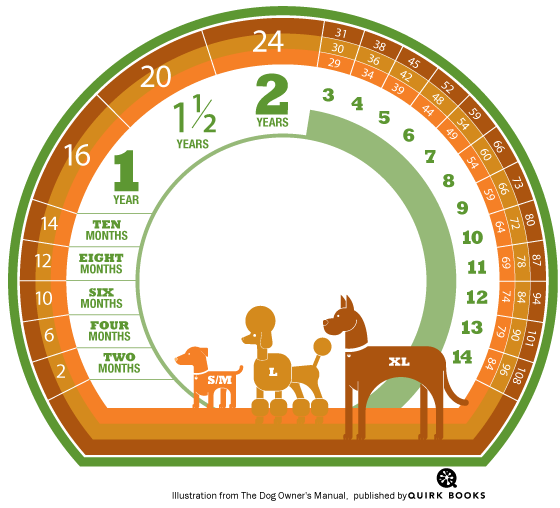 A popular misconception is that dogs age 7 years for each calendar year. In fact, canine aging is much more rapid during the first 2 years of a dog's life. After the first 2 years the ratio settles down to 5 to 1 for small and medium breeds. For large breeds the rate is 6 to 1, and for giant breeds the rate is 7 to 1. Thus, at 10 years of age a Great Dane would be 80 years old while a pug would only be 64. How to Tell a Dog's Age If you've taken in a dog whose age is unknown, there are some ways to determine his age. Here are some things vets check to get a general sense of how old a dog is: The Teeth: Dogs usually have a set of permanent teeth by their seventh month, so if you've come across a dog with clean pearly whites, he is likely a year old or thereabouts. Yellowing on a dog's back teeth may put the dog between one and two years of age, while tartar build-up at a minimal level could mean you have a dog between 3 and 5. Missing teeth or severe wear usually means the dog is a senior and could use some special dental care. Muscle Tone: Younger dogs are more likely to have some muscle definition from their higher activity level. Older dogs are usually either a tad bonier or a little fatter from decreased activity. The Coat: A younger dog usually has a soft, fine coat, whereas an older dog tends to have thicker, coarser (and sometimes oilier) fur. A senior dog may display grays or patches of white, particularly around the snout. The Eyes: Bright, clear eyes without tearing or discharge are common in younger dogs. Cloudy or opaque eyes may mean an older dog. Use this chart to calculate your dog's age: Old Age in Dogs
The age at which a dog can be considered elderly varies widely among models. In general, the larger the dog, the more quickly it declines. For instance, a Great Dane could be considered "senior" at age 5, while a smaller toy poodle would still be spry at twice that age. Remember, however, that just because a dog is chronologically old doesn't mean that an endless series of malfunctions is in store. In many cases an elderly dog can enjoy many healthy, active, pain-free years. One of the best ways to prolong the life and improve the functions of an elderly dog is to carefully regulate its fuel intake. Older dogs exercise less and thus need fewer calories. And since age reduces their ability to digest and absorb nutrients, high-quality food specifically formulated for their needs is a necessity. Excessive amounts of protein, phosphorus, and sodium can aggravate kidney and heart problems, so most such foods contain smaller amounts of higher-quality protein, along with reduced quantities of other elements. Levels of vitamins, zinc, fatty acids, and fiber, however, are increased. BY http://www.dogster.com/dogs-101/calculate-dog-age-in-dog-years
0 Comments
Stolen Dog Reunited With Owner After 7 Years A dog that was stolen from it's backyard almost 7 years ago has been reunited with it's shocked owners. On the day after Thanksgiving in 2003, Brad and Amy Davis and their three children reported their nine-month old Weimaraner called "Jake" as stolen. The Davis family had gone to have their Christmas pictures taken and were away from their home for no more than 45 minutes. That was enough time, however, for thieves to steal their dog from the backyard, leaving his collar behind. "He had been a Houdini-like dog in the past," Amy Davis said, "but there was no way he would have been able to get the collar off by himself." Despite offering rewards for his return, the family never received any news or updates about Jake's whereabouts. And after nearly seven years had passed, the Davis family had given up hope of ever finding their dog again. On September 7th, however, Phyllis Arsenault, a recovery specialist from the American Kennel Club's Companion Animal Recovery (AKC CAR), the nation's largest not-for-profit pet recovery service, called the Davises to say Jake had been found as a result of his microchip being scanned at the Estill County Animal Shelter in Ravenna, Kentucky - over 420 miles and 7 hours from their home in Michigan. The Davises learned that Jake had been dropped off at the shelter by a gentleman who had found him running in the street. "The really strange thing is that when we got the calls, we had just returned from Kentucky and our son's BMX race - we were only about 100 miles away from him!" said Amy. Since his return, Jake has transitioned back into his family quite easily, even making friends with the Davises' new six-month-old puppy. "When the shelter staff contacted us I was really glad we had the family's updated information in our database and that we were able to reunite them with Jake," said Phyllis Arsenault, the recovery specialist who handled the case. "When I spoke to Brad, he was just ecstatic about his dog's return." According to the American Kennel Club's National Pet Theft Database, based on customer and media reports, approximately 177 pets have been reported stolen so far in 2010 compared to 162 in 2009 and 71 in 2008. And this case demonstrates the importance of microchip identification in the fight against pet theft. Photograph courtesy American Kennel Club by Daphne Reid |
NYC walkers Blog
Trusted and Respected NYC Dog Walkers-Insured & Bonded. Archives
May 2021
Categories
All
|

 RSS Feed
RSS Feed